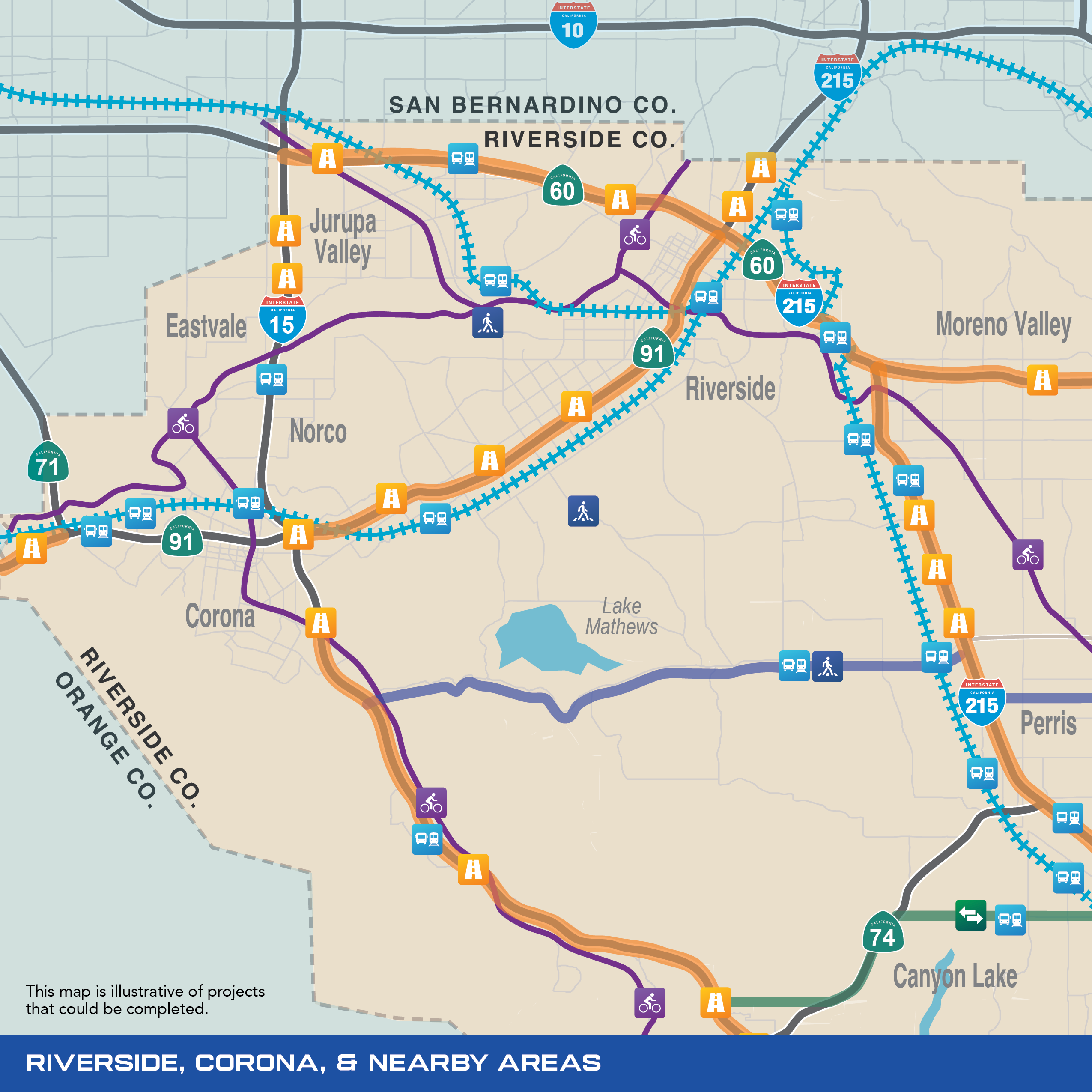Riverside, Corona & Nearby Areas
The Traffic Relief Plan is a county-wide strategy to improve traffic flow and safety, keep infrastructure in good condition, provide greater access to public transportation, and keep Riverside County as a region of opportunity for its residents. RCTC developed the Plan based on feedback from Riverside County residents and their elected representatives.
Safe Streets & Roads
The Plan includes comprehensive safe streets and road improvements throughout this region including pothole repair and road maintenance; sidewalks and pedestrian safety infrastructure; protected bicycle lanes; roadway improvements in high-accident areas; bus shelters; bridge repairs; improvements to railroad crossings, including bridges to separate roads from railroad tracks (grade separations); traffic calming measures; bypass roads and median barriers. In this region, there is a special need for protecting roads, sidewalks, and bicycle facilities from flooding and other natural hazards. The Plan also builds upon innovative emerging technology by including technology to synchronize and interconnect traffic signals; improvements to provide accessibility for persons with disabilities.
Examples include:
- Improve major roads such as Cajalco Road between I-15 and I-215
- Van Buren Boulevard
- Grade separations in the cities of Riverside, Jurupa Valley, Banning, Beaumont, and unincorporated Riverside County
Highways
Improving traffic flow on state highways by constructing new lanes, improving interchanges (on-and off-ramps and bridges) and public transportation facilities, and utilizing innovative technologies.
Examples include:
- Add at least one lane in each direction on I-15 between State Route 74 to the San Diego County Line
- Improve interchange bridges and ramps at State Route 91 and Adams Street
- Improve interchange at State Route 91 and Tyler Street
- Improve interchange at I-215 and Columbia Avenue
- Improve interchange at I-215 and Center Street
- Improve interchange at State Route 60 and Etiwanda Avenue
- Improve interchange at State Route 60 and Rubidoux Boulevard
- Reconstruct interchange on I-15 at Cantu-Galleano Ranch Road in Eastvale
- Reconstruct interchange on I-15 at Sixth Street in Norco
- Construct auxiliary lanes on I-15 and State Route 91 in Corona and Riverside
- Add Express Lanes on I-215 between the 60/90/215 interchange the 60/215 junction
- Add at least one new lane on State Route 91 between State Route 241 and State Route 71 in the eastbound direction
- Add at least one new lane on State Route 91 between I-15 in Corona and Pierce Street in Riverside in both directions
- Construct a rapid transit connection from the 91 Express Lanes to the North Main Corona Transit Center/Metrolink station
- Add at least one lane on I-215 in each direction between State Route 60 and Van Buren Boulevard
- Construct a new interchange on I-15 at Campbell Rancho Road and Temescal Canyon Road in Temescal Valley
- Sustain and increase Freeway Service Patrol on I-215, SR-60, and SR-91
Regional Connections
Constructing multi-modal transportation corridors that connect parts of Riverside County, relieving congestion on existing highways and local roads.
Public Transportation
Increasing frequency and safety of passenger trains and buses; building new tracks, parking, and stations; sustaining and extending rail service throughout the county; expanding bus service options including rapid/express buses; on-demand transit options known as “micro-transit”; modernizing and adding zero-emission buses; providing targeted transit services and keeping bus fares low for seniors, veterans, students, and individuals with disabilities; upgrading bus stops and amenities; and improving connections between home, school, and employment centers.
Examples include:
- Increase train service frequency on existing commuter rail (Metrolink) lines such as the 91/Perris Valley Line and Inland-Empire Orange County (IE/OC) Line
- Maintain and enhance existing stations in Corona, Riverside, and Jurupa Valley
- Construct new parking capacity at stations in Corona and Riverside
- Expand daily passenger rail service (CV Rail) to the Coachella Valley from the Riverside, San Bernardino, Orange, and Los Angeles counties with the construction of new rail stations. CV Rail will transform, connect, promote sustainability, create access and equity, expand economic investment and tourism, and offer more travel choices for this rapidly growing region
- Study and implement options for passenger rail expansions and connections along the region’s highway systems, such as the I-15, I-215, SR-91, and SR-60, if determined to be technically viable and financially feasible with state and federal funding support
- Partnering with employers to encourage alternative forms of commuting, including rideshare and vanpool/carpooling incentives as means to reduce congestion
Active Transportation
Improving safety and expanding access to pedestrian and bicycle facilities such as sidewalks and bicycle lanes, in addition to improving and expanding public access to recreational trails and open spaces and natural areas. The Plan will allow cities to make decisions regarding access methods such as bridges and other connections for pedestrians.
Examples include completing Riverside County’s trail network at:
- Santa Ana River Trail,
- Butterfield Overland Trail/Southern Emigrant Trail
